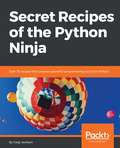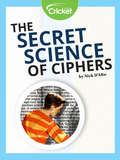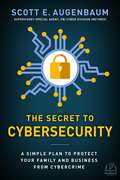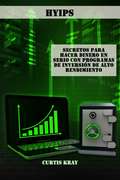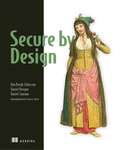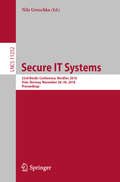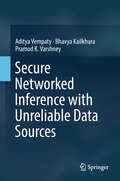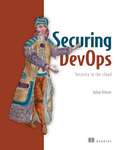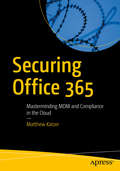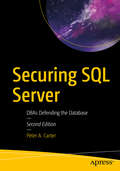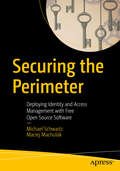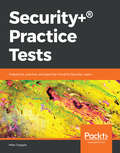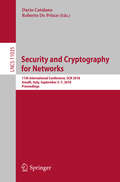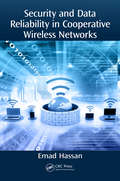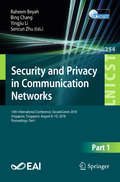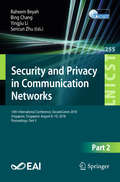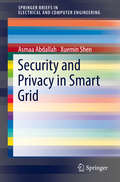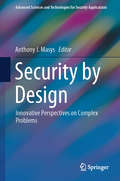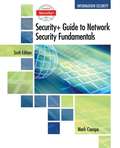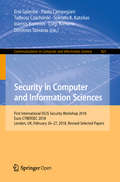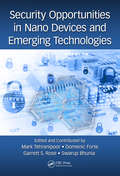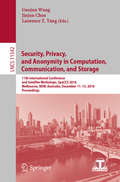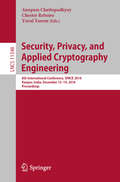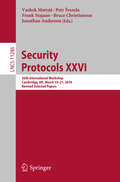- Table View
- List View
Secret Coders: Potions & Parameters (Secret Coders #5)
by Gene Luen YangFrom graphic novel superstar (and former computer programming teacher) and New York Times bestselling author Gene Luen Yang, Secret Coders: Potions & Parameters is the fifth volume in a wildly entertaining series that combines logic puzzles and basic coding instruction with a page-turning mystery plot!Dr. One-Zero won't stop until the whole town—no, the whole world—embraces the "true happiness” found in his poisonous potion, Green Pop. And now that he has the Turtle of Light, he’s virtually unstoppable.There's one weapon that can defeat him: another Turtle of Light. Unfortunately, they can only be found in another dimension! To open a portal to this new world, Hopper, Eni, and Josh's coding skills will be put to the test.
Secret Recipes of the Python Ninja: Over 70 recipes that uncover powerful programming tactics in Python
by Cody JacksonTest your Python programming skills by solving real-world problemsKey FeaturesAccess built-in documentation tools and improve your code.Discover how to make the best use of decorator and generator functionsEnhance speed and improve concurrency by conjuring tricks from the PyPy projectBook DescriptionThis book covers the unexplored secrets of Python, delve into its depths, and uncover its mysteries.You’ll unearth secrets related to the implementation of the standard library, by looking at how modules actually work. You’ll understand the implementation of collections, decimals, and fraction modules. If you haven’t used decorators, coroutines, and generator functions much before, as you make your way through the recipes, you’ll learn what you’ve been missing out on. We’ll cover internal special methods in detail, so you understand what they are and how they can be used to improve the engineering decisions you make. Next, you’ll explore the CPython interpreter, which is a treasure trove of secret hacks that not many programmers are aware of. We’ll take you through the depths of the PyPy project, where you’ll come across several exciting ways that you can improve speed and concurrency. Finally, we’ll take time to explore the PEPs of the latest versions to discover some interesting hacks.What you will learnKnow the differences between .py and .pyc files Explore the different ways to install and upgrade Python packagesUnderstand the working of the PyPI module that enhances built-in decoratorsSee how coroutines are different from generators and how they can simulate multithreadingGrasp how the decimal module improves floating point numbers and their operationsStandardize sub interpreters to improve concurrencyDiscover Python’s built-in docstring analyzerWho this book is forWhether you’ve been working with Python for a few years or you’re a seasoned programmer, you’ll have a lot of new tricks to walk away with.
The Secret Science of Ciphers
by Nick D'AltoEven if you aren't a spy, you probably already use cryptography, or the science of secret communication, every day.
The Secret to Cybersecurity: A Simple Plan to Protect Your Family and Business from Cybercrime
by Scott AugenbaumCybercrimes are a threat and as dangerous as an armed intruder—yet millions of Americans are complacent or simply uninformed of how to protect themselves. The Secret to Cybersecurity closes that knowledge gap by using real-life examples to educate readers.It’s 2 a.m.—do you know who your child is online with? According to author Scott Augenbaum, between 80 to 90 percent of students say they do whatever they want on their smartphones—and their parents don’t have a clue. Is that you? What about your online banking passwords, are they safe? Has your email account or bank/debit card ever been compromised? In 2018, there were data breaches at several major companies—If those companies have your credit or debit information, that affects you. There are bad people in the world, and they are on the internet. They want to hurt you. They are based all over the world, so they’re hard at “work” when even you’re sleeping. They use automated programs to probe for weaknesses in your internet security programs. And they never stop. Cybercrime is on the increase internationally, and it’s up to you to protect yourself. But how? The Secret to Cybersecurity is the simple and straightforward plan to keep you, your family, and your business safe. Written by Scott Augenbaum, a 29-year veteran of the FBI who specialized in cybercrimes, it uses real-life examples to educate and inform readers, explaining who/why/how so you’ll have a specific takeaway to put into action for your family. Learn about the scams, methods, and ways that cyber criminals operate—and learn how to avoid being the next cyber victim.
Secretos para Hacer Dinero en Serio con Programas de Inversión de Alto Rendimiento (HYIPS)
by Curtis KrayDecidí escribir este libro para poder ayudar a todas esas decenas de miles de pequeños inversionistas que se han integrado a Programas de Inversión de Alto Rendimiento (HYIPs) cada año con la esperanza de hacer dinero suficiente para vivir y que, invariablemente han terminado seriamente devastados. Estoy convencido de que la mayoría de la gente que pierde dinero al invertir en HYIPs, carece de la información fundamental sobre su funcionamiento, sobre quienes integran éste juego, y sobre cuál es su verdadera motivación. Para que todos los procesos intelectuales, actitudes y trampas que se tienen que enfrentar puedan entenderse fácilmente es que he escrito este libro. Con la información que se incluye en él, se podrán aprovechar desde distintos ángulos, ingeniosas oportunidades que pondrán en ventaja al inversionista para generar grandes cantidades de dinero.
Secure by Design
by Daniel Sawano Dan Bergh Johnsson Daniel DeogunAs a developer, you need to build software in a secure way. But you can't spend all your time focusing on security. The answer is to use good design principles, tools, and mindsets that make security an implicit result - it's secure by design. Secure by Design teaches developers how to use design to drive security in software development. This book is full of patterns, best practices, and mindsets that you can directly apply to your real world development. Purchase of the print book includes a free eBook in PDF, Kindle, and ePub formats from Manning Publications.
Secure IT Systems: 23rd Nordic Conference, NordSec 2018, Oslo, Norway, November 28-30, 2018, Proceedings (Lecture Notes in Computer Science #11252)
by Nils GruschkaThis book constitutes the refereed proceedings on the 23rd Nordic Conference on Secure IT Systems, NordSec 2018, held in Oslo, Norway, in November 2018.The 29 full papers presented in this volume were carefully reviewed and selected from 81 submissions. They are organized in topical sections named: privacy; cryptography; network and cloud security; cyber security and malware; and security for software and software development.
Secure Networked Inference with Unreliable Data Sources
by Pramod K. Varshney Bhavya Kailkhura Aditya VempatyThe book presents theory and algorithms for secure networked inference in the presence of Byzantines. It derives fundamental limits of networked inference in the presence of Byzantine data and designs robust strategies to ensure reliable performance for several practical network architectures. In particular, it addresses inference (or learning) processes such as detection, estimation or classification, and parallel, hierarchical, and fully decentralized (peer-to-peer) system architectures. Furthermore, it discusses a number of new directions and heuristics to tackle the problem of design complexity in these practical network architectures for inference.
Securing DevOps: Security in the Cloud
by Julien VehentSummarySecuring DevOps explores how the techniques of DevOps and security should be applied together to make cloud services safer. This introductory book reviews the latest practices used in securing web applications and their infrastructure and teaches you techniques to integrate security directly into your product. You'll also learn the core concepts of DevOps, such as continuous integration, continuous delivery, and infrastructure as a service.Purchase of the print book includes a free eBook in PDF, Kindle, and ePub formats from Manning Publications.About the TechnologyAn application running in the cloud can benefit from incredible efficiencies, but they come with unique security threats too. A DevOps team's highest priority is understanding those risks and hardening the system against them.About the BookSecuring DevOps teaches you the essential techniques to secure your cloud services. Using compelling case studies, it shows you how to build security into automated testing, continuous delivery, and other core DevOps processes. This experience-rich book is filled with mission-critical strategies to protect web applications against attacks, deter fraud attempts, and make your services safer when operating at scale. You'll also learn to identify, assess, and secure the unique vulnerabilities posed by cloud deployments and automation tools commonly used in modern infrastructures. What's insideAn approach to continuous securityImplementing test-driven security in DevOpsSecurity techniques for cloud servicesWatching for fraud and responding to incidentsSecurity testing and risk assessmentAbout the ReaderReaders should be comfortable with Linux and standard DevOps practices like CI, CD, and unit testing.About the AuthorJulien Vehent is a security architect and DevOps advocate. He leads the Firefox Operations Security team at Mozilla, and is responsible for the security of Firefox's high-traffic cloud services and public websites.Table of ContentsSecuring DevOpsPART 1 - Case study: applying layers of security to a simple DevOps pipelineBuilding a barebones DevOps pipeline Security layer 1: protecting web applications Security layer 2: protecting cloud infrastructures Security layer 3: securing communications Security layer 4: securing the delivery pipeline PART 2 - Watching for anomalies and protecting services against attacksCollecting and storing logs Analyzing logs for fraud and attacks Detecting intrusions The Caribbean breach: a case study in incident response PART 3 - Maturing DevOps securityAssessing risks Testing security Continuous security
Securing Office 365: Masterminding MDM and Compliance in the Cloud
by Matthew KatzerUnderstand common security pitfalls and discover weak points in your organization’s data security, and what you can do to combat them. This book includes the best approaches to managing mobile devices both on your local network and outside the office.Data breaches, compliance fines, and distribution of personally identifiable information (PII) without encryption or safeguards place businesses of all types at risk. In today’s electronic world, you must have a secure digital footprint that is based on business processes that are designed to protect information. This book is written for business owners, chief information security officers (CISO), and IT managers who want to securely configure Office 365. You will follow the Microsoft cybersecurity road map through a progressive tutorial on how to configure the security services in Office 365 to protect and manage your business.What You’ll LearnManage security with the Azure Security Center and the Office 365 Compliance CenterConfigure information protection for document and electronic communicationsMonitor security for your business in the cloudUnderstand Mobile Application Management (MAM) and Mobile Device Management (MDM)Prevent data loss in Office 365Configure and manage the compliance manager tools for NIST and GDPRWho This Book Is ForIT managers and compliance and cybersecurity officers who have responsibility for compliance and data security in their business
Securing SQL Server: DBAs Defending the Database
by Peter A. CarterProtect your data from attack by using SQL Server technologies to implement a defense-in-depth strategy for your database enterprise. This new edition covers threat analysis, common attacks and countermeasures, and provides an introduction to compliance that is useful for meeting regulatory requirements such as the GDPR. The multi-layered approach in this book helps ensure that a single breach does not lead to loss or compromise of confidential, or business sensitive data.Database professionals in today’s world deal increasingly with repeated data attacks against high-profile organizations and sensitive data. It is more important than ever to keep your company’s data secure. Securing SQL Server demonstrates how developers, administrators and architects can all play their part in the protection of their company’s SQL Server enterprise.This book not only provides a comprehensive guide to implementing the security model in SQL Server, including coverage of technologies such as Always Encrypted, Dynamic Data Masking, and Row Level Security, but also looks at common forms of attack against databases, such as SQL Injection and backup theft, with clear, concise examples of how to implement countermeasures against these specific scenarios. Most importantly, this book gives practical advice and engaging examples of how to defend your data, and ultimately your job, against attack and compromise.What You'll LearnPerform threat analysisImplement access level control and data encryptionAvoid non-reputability by implementing comprehensive auditingUse security metadata to ensure your security policies are enforcedMitigate the risk of credentials being stolenPut countermeasures in place against common forms of attackWho This Book Is ForDatabase administrators who need to understand and counteract the threat of attacks against their company’s data, and useful for SQL developers and architects
Securing the Perimeter
by Michael Schwartz Maciej MachulakLeverage existing free open source software to build an identity and access management (IAM) platform that can serve your organization for the long term. With the emergence of open standards and open source software, it’s now easier than ever to build and operate your own IAM stack.The most common culprit of the largest hacks has been bad personal identification. In terms of bang for your buck, effective access control is the best investment you can make. Financially, it’s more valuable to prevent than to detect a security breach. That’s why Identity and Access Management (IAM) is a critical component of an organization’s security infrastructure. In the past, IAM software has been available only from large enterprise software vendors. Commercial IAM offerings are bundled as “suites” because IAM is not just one component. It’s a number of components working together, including web, authentication, authorization, cryptographic, and persistence services. Securing the Perimeter documents a recipe to take advantage of open standards to build an enterprise-class IAM service using free open source software. This recipe can be adapted to meet the needs of both small and large organizations. While not a comprehensive guide for every application, this book provides the key concepts and patterns to help administrators and developers leverage a central security infrastructure.Cloud IAM service providers would have you believe that managing an IAM is too hard. Anything unfamiliar is hard, but with the right road map, it can be mastered. You may find SaaS identity solutions too rigid or too expensive. Or perhaps you don’t like the idea of a third party holding the credentials of your users—the keys to your kingdom. Open source IAM provides an alternative. Take control of your IAM infrastructure if digital services are key to your organization’s success. What You’ll Learn Understand why you should deploy a centralized authentication and policy management infrastructureUse the SAML or Open ID Standards for web or single sign-on, and OAuth for API Access ManagementSynchronize data from existing identity repositories such as Active DirectoryDeploy two-factor authentication servicesWho This Book Is For Security architects (CISO, CSO), system engineers/administrators, and software developers
Security+® Practice Tests: Prepare for, practice, and pass the CompTIA Security+ exam
by Mike ChappleAce the CompTIA Security+ exam with over 700 practice exam questions written using the style and format of the Security+ exam Key Features Get a detailed breakdown of the type of questions and the exam environment Discover a step-by-step process that guides you through the study process week-by-week Reinforce your learning by solving 100 questions for each domain Book Description Security+ certification is the most popular entry-level certification for cybersecurity professionals. It has no work experience requirement, making it accessible to everyone willing to put in the time to prepare for the exam. Security+? Practice Tests are the perfect tools to prepare for the CompTIA Security+ exam. The first six chapters each cover one of the six Security+ domains. Each of those chapters contains around 100 practice test questions covering the material from that domain. The last two chapters each contain a full-length Security+ practice test that's designed to assess your readiness to take the actual test. At the end of each chapter, you'll find the answers to all of the questions along with detailed explanations to help reinforce your learning of the material. By the end of the book, you'll have enough practice to easily ace the CompTIA Security+ exam. What you will learn Familiarize yourself with the format of the Security+ exam Target your test preparation on each of the Security+ domains Brush up on your understanding by testing yourself on realistic practice questions Discover areas for improvement by comparing your responses to the answers provided Measure your readiness with full-length practice tests Know what to expect on test day and Learn helpful strategies for tackling the different question types Who this book is for This book is designed for service desk analysts, system support engineers, and other IT professionals who want to start their career in managing the IT infrastructure of an organization. Basic knowledge of hardware, software, other relevant components of the IT industry will help you easily grasp the concepts explained in this book.
Security and Cryptography for Networks: 11th International Conference, SCN 2018, Amalfi, Italy, September 5–7, 2018, Proceedings (Lecture Notes in Computer Science #11035)
by Dario Catalano Roberto De PriscoThis book constitutes the proceedings of the 11th International Conference on Security and Cryptography for Networks, SCN 2018, held in Amalfi, Italy, in September 2018.The 30 papers presented in this volume were carefully reviewed and selected from 66 submissions. They are organized in topical sections on signatures and watermarking; composability; encryption; multiparty computation; anonymity and zero knowledge; secret sharing and oblivious transfer; lattices and post quantum cryptography; obfuscation; two-party computation; and protocols.
Security and Data Reliability in Cooperative Wireless Networks
by Emad HassanFollowing a detailed overview of cooperative communications and the physical layer security, this book proposes relay and jammer selection schemes for security in one-way cooperative networks and to improve physical layer security in two-way cooperative networks. It also proposes a Cooperative Hybrid Self-Healing scheme to enhance the confidentiality of the data collected by UWSN. It ends with a proposal called Self-Healing Cluster Controlled Mobility (SH-CCM) scheme based on hybrid cooperation between both Proactive and Reactive peers and the sick sensors at both network and cluster levels to guarantee the security in UWSN.
Security and Privacy in Communication Networks: 14th International Conference, Securecomm 2018, Singapore, Singapore, August 8-10, 2018, Proceedings, Part I (Lecture Notes of the Institute for Computer Sciences, Social Informatics and Telecommunications Engineering #254)
by Raheem Beyah Bing Chang Yingjiu Li Sencun Zhu"This two-volume set LNICST 254-255 constitutes the post-conference proceedings of the 14thInternational Conference on Security and Privacy in Communication Networks, SecureComm 2018, held in Singapore in August 2018. <P><P> The 33 full and 18 short papers were carefully reviewed and selected from 108 submissions. The papers are organized in topical sections on IoT security, user and data privacy, mobile security, wireless security, software security, cloud security, social network and enterprise security, network security, applied cryptography, and web security."
Security and Privacy in Communication Networks: 14th International Conference, Securecomm 2018, Singapore, Singapore, August 8-10, 2018, Proceedings, Part I (Lecture Notes of the Institute for Computer Sciences, Social Informatics and Telecommunications Engineering #254)
by Raheem Beyah Bing Chang Yingjiu Li Sencun Zhu"This two-volume set LNICST 254-255 constitutes the post-conference proceedings of the 14thInternational Conference on Security and Privacy in Communication Networks, SecureComm 2018, held in Singapore in August 2018. <P><P> The 33 full and 18 short papers were carefully reviewed and selected from 108 submissions. The papers are organized in topical sections on IoT security, user and data privacy, mobile security, wireless security, software security, cloud security, social network and enterprise security, network security, applied cryptography, and web security."
Security and Privacy in Smart Grid (SpringerBriefs in Electrical and Computer Engineering)
by Asmaa Abdallah Xuemin ShenThis SpringerBrief addresses the main security concerns for smart grid, e.g., the privacy of electricity consumers, the exchanged messages integrity and confidentiality, the authenticity of participated parties, and the false data injection attacks. Moreover, the authors demonstrate in detail the various proposed techniques to secure the smart grid’s different communication networks and preserve the privacy of the involved. Over many years, power grid has generated electricity from central generators and distributed it in one direction from the generation stations to end-users; also, information is one directional so that the grid’s control center doesn’t get enough information about customers’ requirements and consequently can’t prevent electricity losses. So, the electricity grid is merged with information and communication technology to form smart grid. The main target of this incorporation is to connect different parties of power grid to exchange information about grid conditions and customers’ requirements, and consequently, improve the reliability and efficiency of electricity generation and distribution. That upgrade of the power grid exposes it to the cyber security threats that the communication networks suffer from, such as malicious attacks to forge the electricity consumption readings or price, extract personal information for residential consumers, such as daily habits and life style, or attack some grid’s resources and equipment availability using denial-of-service attacks. Also, novel threats are introduced in smart grid due to the power grid nature, such as false data injection attack, in which the adversary compromises several measurement units and injects false information about the grid conditions that mislead the grid’s control center to make wrong decisions for the grid and consequently impact on its stability and efficiency.
Security by Design: Innovative Perspectives on Complex Problems (Advanced Sciences and Technologies for Security Applications)
by Anthony J. MasysThis edited book captures salient global security challenges and presents ‘design’ solutions in dealing with wicked problems. Through case studies and applied research this book reveals the many perspectives, tools and approaches to support security design. Security design thereby can support risk and threat analysis, risk communication, problem framing and development of interventions strategies. From the refugee crisis to economic slowdowns in emerging markets, from ever-rising numbers of terrorist and cyberattacks to global water shortages, to the proliferation of the Internet of Things and its impact on the security of our homes, cities and critical infrastructure, the current security landscape is diverse and complex. These global risks have been in the headlines in the last year (Global Risks Report) and pose significant security challenges both nationally and globally. In fact, national security is no longer just national. Non-state actors, cyber NGO, rising powers, and hybrid wars and crimes in strategic areas pose complex challenges to global security. In the words of Horst Rittel (1968):"Design is an activity, which aims at the production of a plan, which plan -if implemented- is intended to bring about a situation with specific desired characteristics without creating unforeseen and undesired side and after effects."
Security+ Guide To Network Security Fundamentals (Sixth Edition)
by Mark CiampaComprehensive, practical, and completely up to date, best-selling COMPTIA SECURITY+ GUIDE TO NETWORK SECURITY FUNDAMENTALS, 6e, provides a thorough introduction to network and computer security that prepares you for professional certification and career success. Mapped to the new CompTIA Security+ SY0-501 Certification Exam, the text provides comprehensive coverage of all domain objectives. The sixth edition also includes expansive coverage of embedded device security, attacks and defenses, and the latest developments and trends in information security, including new software tools to assess security.
Security in Computer and Information Sciences: First International ISCIS Security Workshop 2018, Euro-CYBERSEC 2018, London, UK, February 26-27, 2018, Revised Selected Papers (Communications in Computer and Information Science #821)
by Erol Gelenbe Paolo Campegiani Tadeusz Czachórski Sokratis K. Katsikas Ioannis Komnios Luigi Romano Dimitrios TzovarasThis open access book constitutes the thoroughly refereed proceedings of the First International ISCIS Security Workshop 2018, Euro-CYBERSEC 2018, held in London, UK, in February 2018. The 12 full papers presented together with an overview paper were carefully reviewed and selected from 31 submissions. Security of distributed interconnected systems, software systems, and the Internet of Things has become a crucial aspect of the performance of computer systems. The papers deal with these issues, with a specific focus on societally critical systems such as health informatics systems, the Internet of Things, energy systems, digital cities, digital economy, mobile networks, and the underlying physical and network infrastructures.
Security Opportunities in Nano Devices and Emerging Technologies
by Mark Tehranipoor, Domenic Forte, Garrett S. Rose and Swarup BhuniaThe research community lacks both the capability to explain the effectiveness of existing techniques and the metrics to predict the security properties and vulnerabilities of the next generation of nano-devices and systems. This book provides in-depth viewpoints on security issues and explains how nano devices and their unique properties can address the opportunities and challenges of the security community, manufacturers, system integrators, and end users. This book elevates security as a fundamental design parameter, transforming the way new nano-devices are developed. Part 1 focuses on nano devices and building security primitives. Part 2 focuses on emerging technologies and integrations.
Security, Privacy, and Anonymity in Computation, Communication, and Storage: Spaccs 2017 International Workshops, Guangzhou, China, December 12-15, 2017, Proceedings (Lecture Notes in Computer Science #10658)
by Guojun Wang Jinjun Chen Laurence T. YangThis book constitutes the refereed proceedings of the 11th International Conference on Security, Privacy, and Anonymity in Computation, Communication, and Storage. The 45 revised full papers were carefully reviewed and selected from 120 submissions. The papers cover many dimensions including security algorithms and architectures, privacy-aware policies, regulations and techniques, anonymous computation and communication, encompassing fundamental theoretical approaches, practical experimental projects, and commercial application systems for computation, communication and storage.
Security, Privacy, and Applied Cryptography Engineering: 8th International Conference, SPACE 2018, Kanpur, India, December 15-19, 2018, Proceedings (Lecture Notes in Computer Science #11348)
by Anupam Chattopadhyay Chester Rebeiro Yuval YaromThis book constitutes the refereed proceedings of the 8th International Conference on Security, Privacy, and Applied Cryptography Engineering, SPACE 2018, held in Kanpur, India, in December 2018. The 12 full papers presented together with 5 short paper, were carefully reviewed and selected from 34 submissions. This annual event is devoted to various aspects of security, privacy, applied cryptography, and cryptographic engineering. This is indeed a very challenging field, requiring the expertise from diverse domains, ranging from mathematics to solid-state circuit design.
Security Protocols XXVI: 26th International Workshop, Cambridge, UK, March 19–21, 2018, Revised Selected Papers (Lecture Notes in Computer Science #11286)
by Vashek Matyáš Petr Švenda Frank Stajano Bruce Christianson Jonathan AndersonThis book constitutes the thoroughly refereed post-workshop proceedings of the 26th International Workshop on Security Protocols, held in Cambridge, UK, in March 2018. The volume consists of 17 thoroughly revised invited papers presented together with the respective transcripts of discussions. The theme of this year's workshop was fail-safe and fail-deadly concepts in protocol design. The topics covered included failures and attacks; novel protocols; threat models and incentives; cryptomoney; and the interplay of cryptography and dissent.

